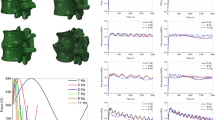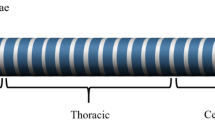Abstract
This study aimed to determine the effect of variations in material properties of the intervertebral disc on dynamic response of the human lumbar spine to vertical vibration using a finite element model of the lumbar L1–S1 motion segment. The present material sensitivity study was conducted by varying elastic moduli for annulus ground substance (AGS), annulus fibers (AF), and nucleus pulposus (NP) in the disc. Transient dynamic analysis was performed initially on the model with basic material property under a sinusoidal vertical vibration load. Subsequently, the same analysis was done for each of the three disc components corresponding to high and low material property cases. The computed results were plotted as a function of time and compared. The AGS property displayed a larger impact on vertebral axial displacement and von Mises stress in AGS, and the AF property displayed a larger impact on disc bulge. In contrast, the NP property had little effect on all the response parameters. Additionally, the intradiscal pressure was found to be not sensitive to any of the disc properties. These findings may be helpful in adoption of appropriate material parameters for the intervertebral disc in finite element model of the lumbar spine used for vibration analysis.

Material property sensitivity analysis on vibration characteristics of the human lumbar spine.






Similar content being viewed by others
References
Anderson AE, Ellis BJ, Weiss JA (2007) Verification, validation and sensitivity studies in computational biomechanics. Comput Methods Biomech Biomed Eng 10(3):171–184
Bovenzi M, Hulshof CTJ (1998) An updated review of epidemiologic studies on the relationship between exposure to whole-body vibration and low back pain. J Sound Vib 215(4):595–611
Dreischarf M, Zander T, Shirazi-Adl A, Puttlitz CM, Adam CJ, Chen CS, Goel VK, Kiapour A, Kim YH (2014) Comparison of eight published static finite element models of the intact lumbar spine: predictive power of models improves when combined together. J Biomech 47(8):1757–1766
Fagan MJ, Julian S, Siddall DJ, Mohsen AM (2002) Patient-specific spine models. Part 1: finite element analysis of the lumbar intervertebral disc-a material sensitivity study. Proc Inst Mech Eng H J Eng Med 216(H5):299–314
Fan W, Guo LX (2017) Influence of different frequencies of axial cyclic loading on time-domain vibration response of the lumbar spine: a finite element study. Comput Biol Med 86:75–81
Goel VK, Park H, Kong WZ (1994) Investigation of vibration characteristics of the ligamentous lumbar spine using the finite element approach. J Biomech Eng 116(4):377–383
Guan YB, Yoganandan N, Moore J, Pintar FA, Zhang JY, Maiman DJ, Laud P (2007) Moment-rotation responses of the human lumbosacral spinal column. J Biomech 40(9):1975–1980
Guo LX, Teo EC, Lee KK, Zhang QH (2005) Vibration characteristics of the human spine under axial cyclic loads: effect of frequency and damping. Spine 30(6):631–637
Guo LX, Wang ZW, Zhang YM, Lee KK, Teo EC, Li H, Wen BC (2009) Material property sensitivity analysis on resonant frequency characteristics of the human spine. J Appl Biomech 25(1):64–72
Jebaseelan DD, Jebaraj C, Yoganandan N, Rajasekaran S, Kanna RM (2012) Sensitivity studies of pediatric material properties on juvenile lumbar spine responses using finite element analysis. Med Biol Eng Comput 50(5):515–522
Kim HJ, Kang KT, Son J, Lee CK, Chang BS, Yeom JS (2015) The influence of facet joint orientation and tropism on the stress at the adjacent segment after lumbar fusion surgery: a biomechanical analysis. Spine J 15(8):1841–1847
Kong WZ, Goel VK (2011) Ability of the finite element models to predict response of the human spine to sinusoidal vertical vibration. Spine 28(17):1961–1967
Kumaresan S, Yoganandan N, Pintar FA (1999) Finite element analysis of the cervical spine: a material property sensitivity study. Clin Biomech 14(1):41–53
Lee KK, Teo EC (2005) Material sensitivity study on lumbar motion segment (L2-L3) under sagittal plane loadings using probabilistic method. J Spinal Disord Tech 18(2):163–170
Lis AM, Black KM, Korn H, Nordin M (2007) Association between sitting and occupational LBP. Eur Spine J 16(2):283–298
Lu YM, Hutton WC, Gharpuray VM (1996) Can variations in intervertebral disc height affect the mechanical function of the disc? Spine 21(19):2208–2216
Magnusson ML, Pope MH, Wilder DG, Areskoug B (1996) Are occupational drivers at an increased risk for developing musculoskeletal disorders? Spine 21(6):710–717
Ng HW, Teo EC, Lee VS (2004) Statistical factorial analysis on the material property sensitivity of the mechanical responses of the C4-C6 under compression, anterior and posterior shear. J Biomech 37(5):771–777
Panjabi M (1979) Validation of mathematical models. J Biomech 12(3):238
Patwardhan AG, Havey RM, Meade KP, Lee B, Dunlap B (1999) A follower load increases the load-carrying capacity of the lumbar spine in compression. Spine 24(10):1003–1009
Polikeit A, Ferguson SJ, Nolte LP, Orr TE (2003) Factors influencing stresses in the lumbar spine after the insertion of intervertebral cages: finite element analysis. Eur Spine J 12(4):413–420
Rao AA, Dumas GA (1991) Influence of material properties on the mechanical behaviour of the L& intervertebral disc in compression: a nonlinear finite element study. J Biomed Eng 13(2):139–151
Renner SM, Natarajan RN, Patwardhan AG, Havey RM, Voronov LI, Guo BY, Andersson GBJ, An HS (2007) Novel model to analyze the effect of a large compressive follower pre-load on range of motions in a lumbar spine. J Biomech 40(6):1326–1332
Rohlmann A, Zander T, Rao M, Bergmann G (2009) Applying a follower load delivers realistic results for simulating standing. J Biomech 42(10):1520–1526
Schmidt H, Heuer F, Simon U, Kettler A, Rohlmann A, Claes L, Wilke HJ (2006) Application of a new calibration method for a three-dimensional finite element model of a human lumbar annulus fibrosus. Clin Biomech 21(4):337–344
Shirazi-Adl A (2006) Analysis of large compression loads on lumbar spine in flexion and in torsion using a novel wrapping element. J Biomech 39(2):267–275
Shirazi-Adl A, Parnianpour M (1996) Role of posture in mechanics of the lumbar spine in compression. J Spinal Disord 9(4):277–286
Spilker RL, Jakobs DM, Schultz AB (1986) Material constants for a finite element model of the intervertebral disc with fibre composite annulus. J Biomech Eng 108:1–11
Stokes IAF, Gardner-Morse M (2016) A database of lumbar spinal mechanical behavior for validation of spinal analytical models. J Biomech 49(5):780–785
Tsai PI, Hsu CC, Chen SY, Wu TH, Huang CC (2016) Biomechanical investigation into the structural design of porous additive manufactured cages using numerical and experimental approaches. Comput Biol Med 76:14–23
Wade KR, Schollum ML, Robertson PA, Thambyah A, Broom ND (2016) ISSLS prize winner: vibration really does disrupt the disc: a microanatomical investigation. Spine 41(15):1185–1198
Wilder DG (1985) On the loading of the human lumbar intervertebral motion segment. Ph.D. dissertation, University of Vermont, Burlington
Wilder DG, Pope MH (1996) Epidemiological and aetiological aspects of low back pain in vibration environments-an update. Clin Biomech 11(2):61–73
Xu M, Yang J, Lieberman IH, Haddas R (2017) Lumbar spine finite element model for healthy subjects: development and validation. Comput Methods Biomech Biomed Eng 20(1):1–15
Zander T, Dreischarf M, Timm AK, Baumann WW, Schmidt H (2017) Impact of material and morphological parameters on the mechanical response of the lumbar spine—a finite element sensitivity study. J Biomech 53:185–190
Funding
We are grateful for the grants from the Fundamental Research Funds for the Central Universities (02090022118032) and the National Natural Science Foundation of China (51275082, 11272273).
Author information
Authors and Affiliations
Corresponding author
Ethics declarations
Conflict of interest
The authors declare that they have no conflict of interest.
Rights and permissions
About this article
Cite this article
Guo, LX., Fan, W. Impact of material properties of intervertebral disc on dynamic response of the human lumbar spine to vertical vibration: a finite element sensitivity study. Med Biol Eng Comput 57, 221–229 (2019). https://doi.org/10.1007/s11517-018-1873-5
Received:
Accepted:
Published:
Issue Date:
DOI: https://doi.org/10.1007/s11517-018-1873-5




